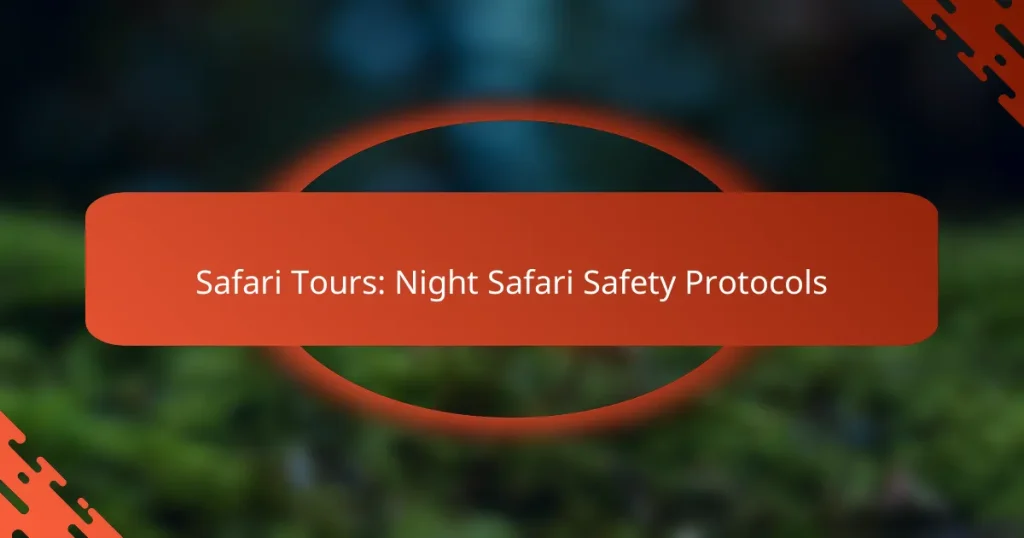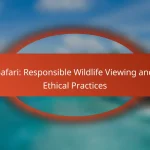Night safaris in Africa offer an exhilarating way to experience wildlife, but safety is paramount. Established protocols guide participants on wildlife interaction, emergency responses, and the importance of proper preparation. By understanding the unique risks associated with limited visibility and wild animals, you can ensure a safe and memorable adventure under the stars.
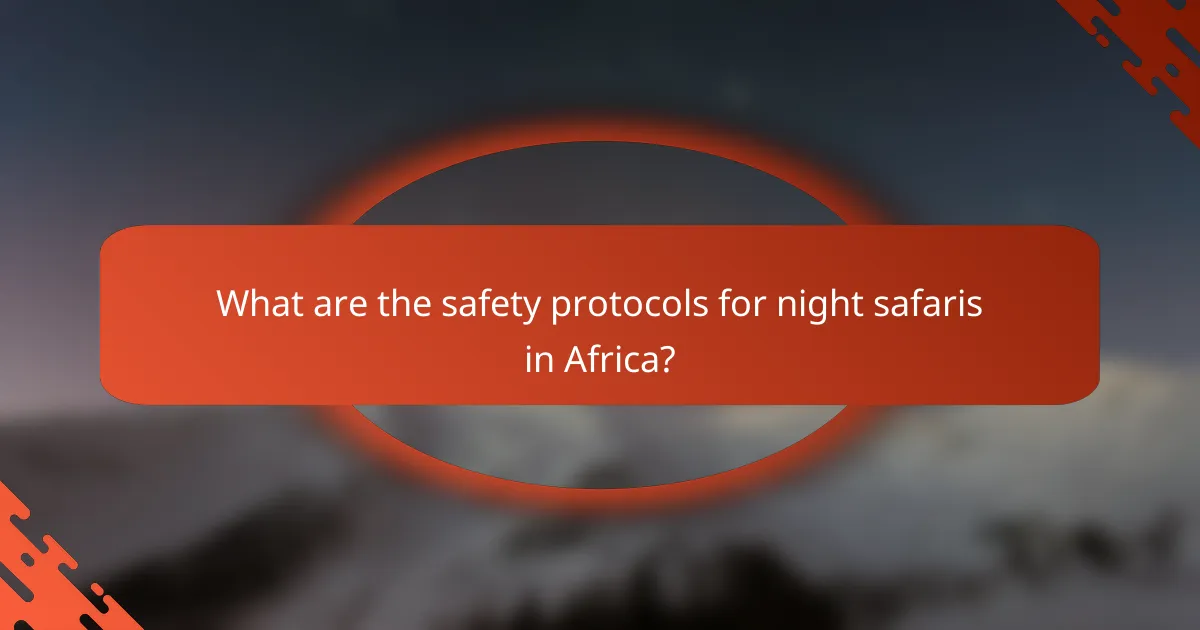
What are the safety protocols for night safaris in Africa?
Night safaris in Africa prioritize safety through established protocols that protect both participants and wildlife. These protocols include guidelines for wildlife interaction, emergency response procedures, equipment checks, group size limitations, and the training of guides.
Wildlife interaction guidelines
Wildlife interaction guidelines are crucial for ensuring the safety of both guests and animals during night safaris. Participants should maintain a safe distance from wildlife, typically at least 25 meters, to avoid startling or provoking animals. Flash photography and loud noises are discouraged as they can disrupt the natural behavior of the animals.
Additionally, guests should follow their guide’s instructions closely, as guides are trained to recognize signs of animal aggression or distress. Understanding animal behavior can significantly enhance safety during encounters.
Emergency response procedures
Emergency response procedures are vital for addressing unexpected situations during night safaris. Each safari operator should have a clear plan in place, including communication protocols with local authorities and medical facilities. Guides are typically trained in first aid and should carry basic medical supplies.
In case of an emergency, guests should remain calm and follow the guide’s instructions. Knowing the nearest evacuation routes and having a designated meeting point can also enhance safety during unforeseen events.
Equipment safety checks
Equipment safety checks are essential to ensure that all gear used during night safaris is functioning properly. This includes inspecting vehicles for mechanical issues, ensuring that headlights and communication devices are operational, and verifying that safety equipment like first aid kits is stocked and accessible.
Guests should also be briefed on how to use any provided equipment, such as night vision goggles or flashlights, to maximize their safety and enjoyment during the safari.
Group size limitations
Group size limitations help maintain a safe and manageable environment during night safaris. Most operators recommend groups of no more than 8 to 12 participants, allowing guides to effectively monitor and communicate with everyone. Smaller groups also reduce the impact on wildlife and enhance the overall experience.
Adhering to these limitations ensures that each participant receives adequate attention and instruction from the guide, which is crucial for safety during wildlife encounters.
Guide training requirements
Guide training requirements are critical for ensuring that safari guides are equipped to handle the unique challenges of night safaris. Guides should undergo comprehensive training that includes wildlife behavior, first aid, and emergency response techniques. Many operators require guides to have certifications from recognized wildlife or tourism organizations.
Experienced guides can enhance safety by making informed decisions during the safari, effectively managing group dynamics, and providing valuable insights into the wildlife observed.
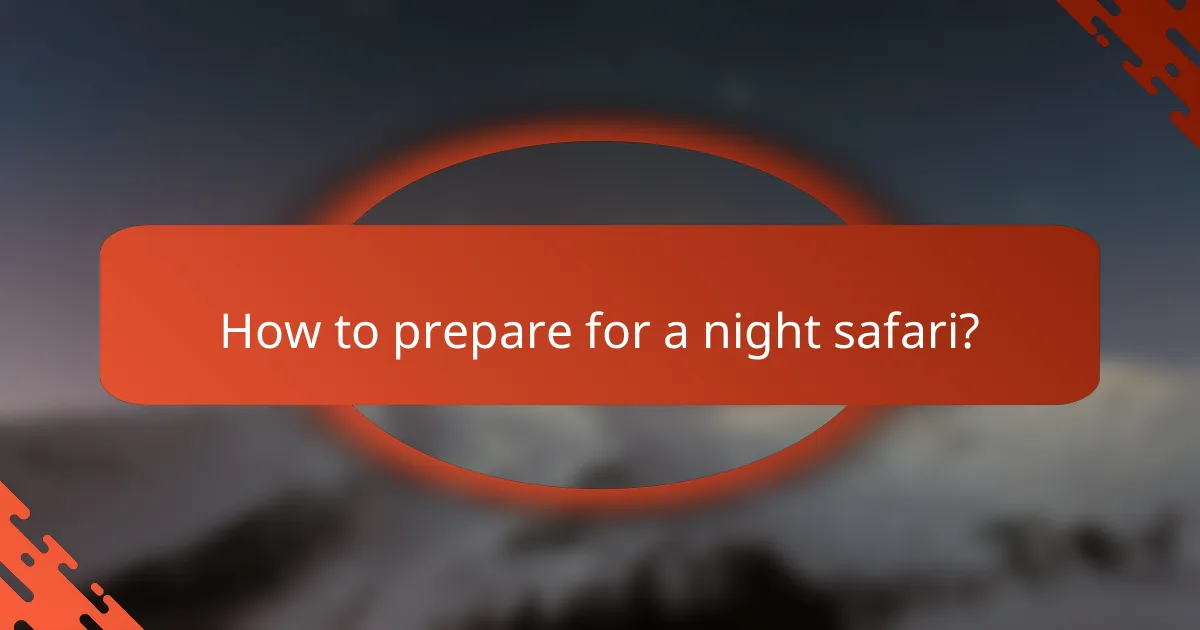
How to prepare for a night safari?
Preparing for a night safari involves gathering essential gear, dressing appropriately, and taking necessary health precautions. Proper preparation enhances your experience and ensures safety while exploring wildlife in the dark.
Essential gear checklist
When preparing for a night safari, ensure you have the right gear to enhance visibility and comfort. Key items include a high-quality flashlight or headlamp, binoculars for wildlife viewing, and a camera with a good low-light capability.
- Water bottle to stay hydrated
- Insect repellent to ward off bugs
- First aid kit for minor injuries
Consider a lightweight backpack to carry your gear, and always check the local regulations regarding equipment allowed on safaris.
Recommended clothing
Dress in layers for a night safari, as temperatures can drop significantly after sunset. Lightweight, breathable clothing is ideal for the warm evening, while a warm jacket or fleece can be useful as the night progresses.
Opt for neutral colors like khaki or olive to blend in with the environment and avoid bright colors that might disturb wildlife. Sturdy, closed-toe shoes are essential for navigating uneven terrain safely.
Health precautions
Before embarking on a night safari, ensure you are up to date on vaccinations, especially if traveling to areas with known health risks. Consult with a healthcare provider about any necessary medications, such as anti-malarials, depending on the region.
Stay hydrated throughout the safari, and be cautious of any allergies, particularly to insect bites. Carrying a small first aid kit can help address minor health issues that may arise during your adventure.
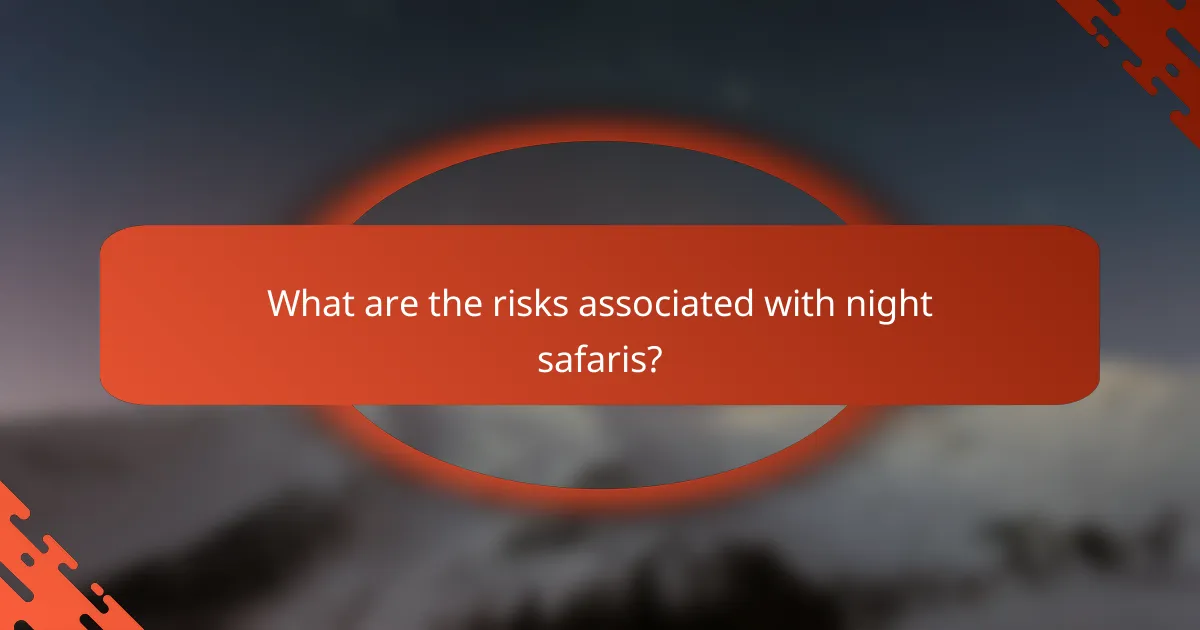
What are the risks associated with night safaris?
Night safaris present unique risks primarily due to limited visibility and the presence of wild animals. Understanding these risks is crucial for ensuring a safe and enjoyable experience.
Wild animal encounters
During night safaris, the likelihood of encountering wild animals increases significantly. Animals are often more active at night, which can lead to unexpected close encounters. It’s essential to remain calm and follow the guide’s instructions if an animal is spotted.
To minimize risks, maintain a safe distance from wildlife and avoid sudden movements. Guides are trained to handle such situations, so trust their expertise and stay within the designated areas.
Environmental hazards
Nighttime conditions can introduce various environmental hazards, such as uneven terrain, low visibility, and potential weather changes. These factors can increase the risk of tripping or falling, especially in dense vegetation or rocky areas.
Wear appropriate footwear with good grip and consider using a flashlight or headlamp to navigate safely. Be aware of your surroundings and watch for obstacles to reduce the risk of injury.
Injury prevention
To prevent injuries during a night safari, follow safety protocols established by your tour operator. Always stay with the group and avoid wandering off, as this can lead to dangerous situations.
Additionally, consider wearing protective clothing, such as long sleeves and pants, to guard against insect bites and scratches from plants. Carry a basic first aid kit for minor injuries and ensure your guide is equipped to handle emergencies.

Which companies offer night safari tours?
Several companies specialize in night safari tours, providing unique experiences to explore wildlife after dark. Popular options include Safari World Tours, Big Five Safaris, and Night Adventures Africa, each offering distinct itineraries and safety protocols.
Safari World Tours
Safari World Tours is known for its comprehensive night safari packages that include guided excursions into wildlife reserves. Their tours typically feature experienced guides who prioritize safety and provide insights into nocturnal animal behavior.
When booking with Safari World Tours, consider their safety protocols, which include vehicle inspections and emergency procedures. Ensure to check their cancellation policies and availability, especially during peak seasons.
Big Five Safaris
Big Five Safaris offers immersive night safari experiences in various national parks. Their tours are designed to maximize wildlife sightings while adhering to strict safety measures, such as maintaining a safe distance from animals and using specialized night-vision equipment.
Before embarking on a tour with Big Five Safaris, review their guidelines on what to bring, such as appropriate clothing and gear. They often recommend early bookings due to limited spots, particularly in high-demand areas.
Night Adventures Africa
Night Adventures Africa focuses on providing thrilling nocturnal wildlife experiences with a strong emphasis on safety. Their tours include trained guides who are knowledgeable about local wildlife and environmental conservation practices.
When choosing Night Adventures Africa, look for their detailed safety briefings and equipment checks. It’s advisable to inquire about group sizes, as smaller groups can enhance the experience and safety during night excursions.
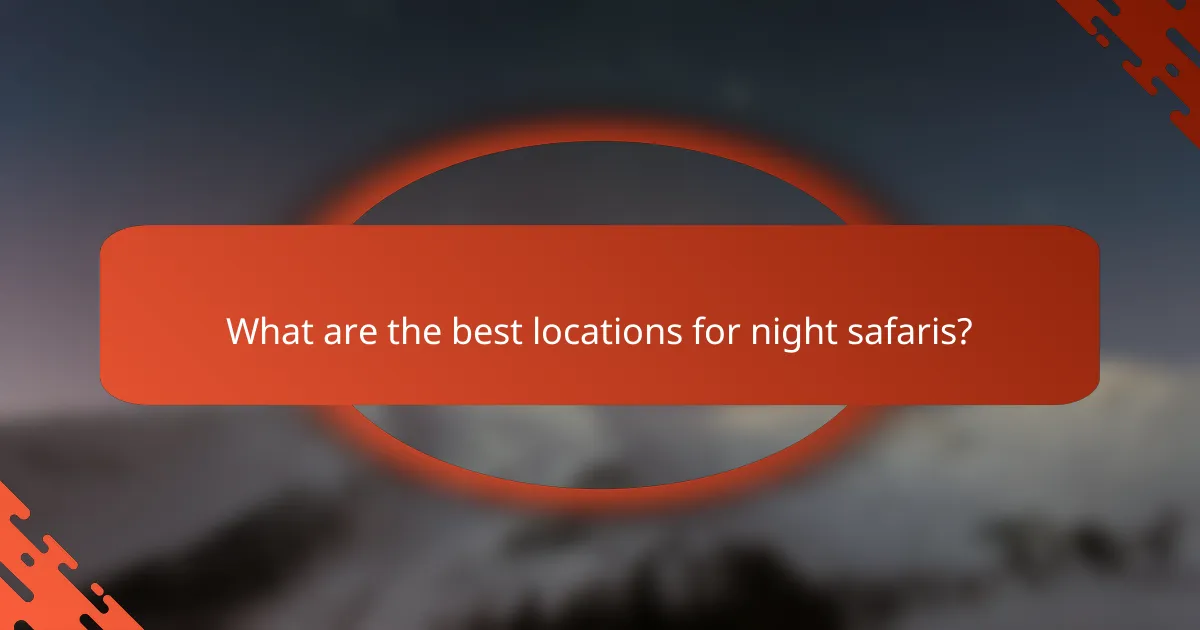
What are the best locations for night safaris?
The best locations for night safaris offer unique wildlife experiences, allowing visitors to observe nocturnal animals in their natural habitats. Popular destinations include Kruger National Park in South Africa and Masai Mara National Reserve in Kenya, each providing distinct opportunities for adventure and wildlife observation.
Kruger National Park
Kruger National Park is renowned for its diverse ecosystems and abundant wildlife, making it an ideal spot for night safaris. Visitors can expect to see a variety of nocturnal species, including leopards, hyenas, and various antelope, all while guided by experienced rangers who ensure safety and enhance the experience.
When planning a night safari in Kruger, it’s essential to book with a reputable tour operator that follows safety protocols. These may include staying within designated areas, using spotlights responsibly, and adhering to park regulations to minimize disturbances to wildlife.
Masai Mara National Reserve
Masai Mara National Reserve offers a thrilling night safari experience, particularly during the Great Migration season. Guests can witness predators like lions and cheetahs in action, as well as the unique sounds of the African night, which adds to the adventure.
For a successful night safari in Masai Mara, choose a lodge or camp that provides guided tours. Ensure that the guides are knowledgeable about local wildlife and safety measures, such as maintaining a safe distance from animals and using proper lighting techniques to avoid startling them.
